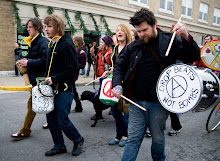
kandinsky's respondeo ut the world of art, in his time, to the past, and for the future of art is widely considered one of the greatest documents on art by an artist. sure, i'll accept that. however, i believe this is more of an assault on the condition of the human spirit than a treatise on the state of art.
kandinsky reiterates, many times, his disgust for the broad acceptance of and reverence towards "stagnate art". as an artist himself, he is quite aware of the vast differences between what the critics and buyers are going in for, and what the artists are doing. he lays out, quite brutally, his own foundation of the future of art. making claims that, the future will hold an art that is un-seeable to the eye, but glaring to the soul. it will have to consist then, of images from within, not without the human field of perception. he is calling for the abandonment of the recognizable, often cliche materialism that academic art of his time heralded as high.
there is nothing lower than a bland reproduction of a bland person in a bland setting. according to kandinsky. this was 191o, and was thus the manual for abstraction that would spawn an art movement that has shaken everything the art world made for thousands of years before it, to it's very core.
kandinsky battles the dominant paradigm of art theory that art should reflect nature, thereby being a discourse with our natural life and thus the voice of divinity. he argues that only true art, free from external form, can be divined and relate to the world, in fact more than that, help the world to progress into a truly spiritual world. he sites many contemporary poets, painters and philosophers, including mme. blavastky philosophy, though she merely developed an idea based upon , credited by hitler as the mother of the aryanhindu teachings she picked while in india. kandisnky is clearly a very well educated and passionate man, albeit angry as all hell.
he seems to, at times, get lost in his own poetic symbolism and dive off of cliffs that are too hard to climb back to. (how was that for poetic irony) he has a chapter called the movement of the triangle, in which he forms a triangle based upon levels of spiritual growth. what is it with metaphysical writers that makes them use obscure geometric charts to illustrate an idea. see ken wilbur if you are not sure what i mean. the chapter wraps up nicely and he makes some very clear points, but the beginning is very slow going and clogged with imagery too complex for his simple implication. he seems to focus on the art that is not spiritual, trying to show by absence the art that is. he sites many styles and trends in art at the time that seem to portray stillborn representations of human life. art, in his and my eye, is to relate the human condition to the future generations that they may understand where we lived. this book is just shy of one hundred years old, and still it is valid in modern conversation.
where wassily had impressionists, we have pop, where he had vase on table with fruit, we have a fucking dead tiger shark in formaldehyde. does the art of today really reflect our universal subconscious. will a fifty million dollar, diamond encrusted skull save the soul of anyone tomorrow, or today for that matter, and still this is what we know as our contemporaries. sure we have our jenny savilles,who is a mind staggering painter, and let us not overlook them, god forbid we let another van gogh slip away. but the damien hirsts are killing me. now, just today i hear about marla olmstead, the four year old abstract expressionist prodigy, whose work is compared to pollock, and dekooning.
marla is all the buzz right now. a four year old whose father is paints, has the spotlight as genius of painting. is this art? is it commodity? nit sch? what do i know. i do know some of the stuff of hers is very cool, and most likely, if seen by unwitting eyes, would be hailed as great work by one who truly suffered and now understands life with color. not sure what i think about that, just an interesting topic right now. what would wassily say? i am sure a part of him would see the beauty and innocence and then the spiritual side of her pictures. but the purist in him would denounce her "work" as simply the play thing of a child, which it is.
all in all, the book really is refreshing in that is a statement of sincerity about art. it is rare that we read a book about art theory that as actually written by an artist. most are like parenting books written by childless doctors. this, however is the real deal. kandinsky is one of the most famous artists of the 20th century, also one of the most prolific writers on art. the book is not finely tuned, but it's rawness is it's energy.

farbstudie quadrate - wassily kandinsky
note kandisnky's influence on contemporaries such as chuck close, who is famed for super-realism, or photo-realism, which completely disembarks from the course set by kandinsky himself. oh the ways we dig our graves and how we praise the soil!
side-note: i will not link damien hirst's name in my blog. if you are curious what his work is like, go to a shopping mall and ask an old woman to kick you in the genitals, you will get more out of that experience, i am sure of this.





